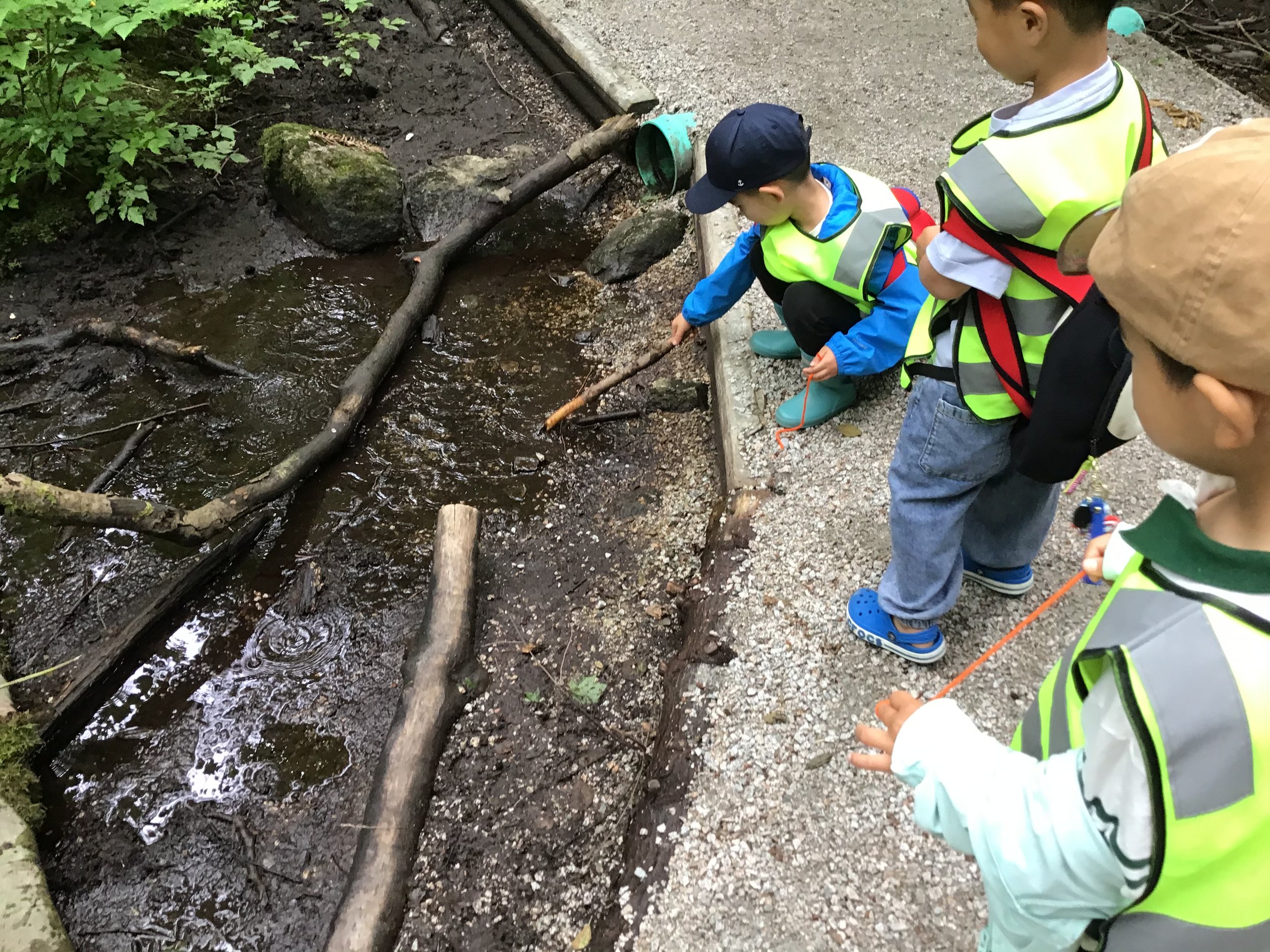Summer 2022
Level 1
This week we explored size and shape and sharpened our spatial awareness by measuring objects using strings of yarn. This made us aware of the wide variety of sizes in our natural world, ranging from tiny seeds to tall trees. We learned about the features of small and large objects, including the different sounds they make. In order to prepare for a summer of outdoor camp, we also used this first day to get comfortable outside and familiarize ourselves with the outdoor elements we will continue to encounter. We went over our safety rules and we brainstormed how we can explore this environment, using it as a place to play and learn.
Who is Hiding Under the Log?
Pacific Spirit Park
July 9
We learned about the curious creatures that live in our forests, the many ways they move, and the many places they hide. We studied the anatomy of insects by studying the shapes and patterns they’re comprised of, and subsequently used our creativity to create imaginary insects of our own. At the end of the day, we played games where we learned to wiggle and slither like bugs at a variety of speeds and rhythms.
Who is Hiding in the Dirt?
Musqueam Park
July 16
This week we explored the diversity of living things around us and identified as many as we could, including bees, ducks, lily pads, and trees. We paid special attention to which plants and animals were grouped together and wondered why we didn’t see them as much in other places, like dragonflies and ponds. We noticed new differences between living things beyond size, such as texture, colour, and pattern. After noticing which plants and animals we saw repeatedly, we were able to notice exotic elements that didn’t fit in, such as bamboo.
Fly and Catch! Insects with Wings
Van Dusen Gardens
July 23
Today we put our engineering, technology, and design skills to the test by creating a minibeast paradise–equipped with all that the little creatures in the park need to live. Later, we expanded our insect vocabulary while learning the types of insects, their life cycles, and their characteristics. Using a partial image of insects, we used our artistic skills to fill in the rest. Most importantly, we learned to respect and empathize with even the tiniest of beasts that live among us.
Fly and Catch! Insects with Wings
Queen Elizabeth
July 30
Today we were detectives and searched for clues in our environment about which creatures had been there and what they had been doing there, like munched leaves and beetle bark. We took full advantage of the diverse environments around the bog by searching for creatures on the ground, in the trees, and in the water. After finding animals in the water, we read a book all about water insects. We then did some math and warmed our bodies up with a traffic light game and some insect-inspired dance moves!
Bug Hotel: Insect Habitat Explorations
Camosun Bog
August 6
Today we thought about the ways animals help each other out. We focused on bigger creatures in the forest–birds, mammals, fungi, and more–and the relationships between them. We moved like different animals and explored our space through games and an exciting scavenger hunt. We made sure to enjoy some meditative time journalling, observing, and completing a math activity to round off the day.
What is a Tide Pool?
Pacific Spirit Park
August 13
Today at Jericho Pond we paid attention to birds, noticing what features they have, like beaks, wings, and feathers. To start, we sang songs as a group and participated in group discussion. In our discussion, we asked questions about birds. We went on a nature walk which included a fun scavenger hunt, we practiced patterns with a math activity, and we had some unstructured play time. Throughout the day, we followed the lead of older students to solidify our safety skills and come closer to independence during play time at the pond.
Aquatic Creatures
Jericho Pond
August 20
Hiding in the Sand
Vanier Park
August 27
Today we continued thinking about birds, especially seagulls! We compared them to other birds and wondered what kinds of things they need to live. When thinking about seagulls, we thought about how they sound and how they float on water. In between talking about gulls, we practiced printing and tracing. This activity taught us about concepts like shape and counting. We were also introduced to the concept of pollution and learned about its causes and effects. We closed our eyes and listened to the sounds around us in some quiet, meditative time before wrapping up the final day of outdoor school!








